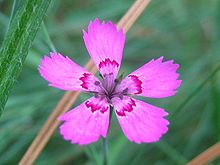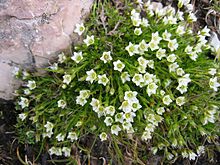Caryophyllaceae
| Carnation family | |
|---|---|

| |
| Silene dioica | |
| Scientific classification | |
| Kingdom: | Plantae |
| Clade: | Tracheophytes |
| Clade: | Angiosperms |
| Clade: | Eudicots |
| Order: | Caryophyllales |
| Family: | Caryophyllaceae Juss.[1] |
Genera
| |
|
Many, see text | |
| Synonyms | |
Caryophyllaceae, commonly called the pink family or carnation family, is a
Cactaceae, and Polygonaceae.[1] It is a large family, with 81 genera and about 2,625 known species.[3]
This
the world's southernmost dicot, which is one of only two flowering plants found in Antarctica.[4]
The name comes from Caryophyllus, an obsolete synonym of Dianthus.[5]
Description
Despite its size and the somewhat doubtful mutual relationships, this family is rather uniform and easily recognizable.
Most are herbaceous
succulent; i.e. having no fleshy stems or leaves. The nodes on the stem are swollen. The leaves are almost always opposite,[7] rarely whorled. The blades are entire, petiolate, and often stipulate. These stipules
are not sheath-forming.
The bisexual
Systematics





Currently, Amaranthaceae and Caryophyllaceae are sister groups and considered closely related.
Formerly, Caryophyllaceae were considered the sister family to all of the remaining members of the suborder
synapomorphy of the suborder.[8]
This family is traditionally divided in three subfamilies:
- Alsinoideae: no stipules, petals not united
- Silenoideae: no stipules, petals united
- Paronychioideae: fleshy stipules, petals separate or united
The last, however, are a
monophyletic at least for the most part, if some of the taxa misplaced in Alsinoideae are moved there; it may be that the name Caryophylloideae would apply for the revised delimitation.[9]
However,
cladistic analysis.[10]
Genera
102 genera are accepted.[11]
- Acanthophyllum C.A.Mey.
- Achyronychia Torr. & A.Gray – onyxflower, frost-mat
- Agrostemma L. – corncockles
- Arenaria Ruppius ex L. – sandworts
- Atocion Adans.
- Augustea Iamonico
- Balkana Madhani & Zarre
- Baretia Timaná
- Bolanthus (Ser.) Rchb.
- Brachystemma D.Don
- Bufonia Sauvage
- Cardionema DC.
- Cerastium Tourn. ex L. – mouse-ear chickweeds
- Cerdia Moc. & Sessé ex DC.
- Chaetonychia (DC.) Sweet
- Cherleria L.
- Colobanthus Bartl. – pearlworts
- Cometes L.
- Corrigiola L. – strapworts
- Cyathophylla Boquet & Strid
- Dianthus L. – carnations and pinks
- Dicheranthus Webb
- Dichodon (Bartl. ex Rchb.) Rchb.
- Drymaria Willd. ex Schult.
- Drypis P.Michell ex L.
- Engellaria Iamonico
- Eremogone Fenzl
- Eudianthe (Rchb.) Rchb.
- Facchinia Rchb.
- Geocarpon Mack.
- Gymnocarpos Forssk.
- Gypsophila L. – gypsophilas, baby's-breath
- Habrosia Fenzl
- Hartmaniella M.L.Zhang & Rabeler
- HayaBalf.f
- Heliosperma (Rchb.) Rchb.
- Herniaria Tourn. ex L. – ruptureworts
- Heterochroa Bunge
- Himgiria Pusalkar & D.K.Singh
- Holosteum Dill. ex L. – jagged chickweeds
- Honckenya Ehrh.
- Illecebrum Ruppius ex L.
- Kabulia Bor & C.E.C.Fisch.
- Krauseola Pax & K.Hoffm.
- Lepyrodiclis Fenzl
- Loeflingia L.
- Mcneillia Dillenb. & Kadereit
- Mesostemma Vved.
- Microphyes Phil.
- Minuartia Loefl. – sandworts, stitchworts
- Minuartiella Dillenb. & Kadereit
- Moehringia L. – sandworts
- Moenchia Ehrh. – upright chickweeds
- Nubelaria M.T.Sharples & E.A.Tripp (previously part of Stellaria)
- Odontostemma Benth. ex G.Don
- Ortegia Loefl.
- Paronychia Mill. – chickweeds
- Pentastemonodiscus Rech.f.
- Petroana Madhani & Zarre
- Petrocoptis A.Braun ex Endl.
- Petrorhagia (Ser.) Link
- PhilippiellaSpeg.
- PhrynellaPax & K.Hoffm.
- Pirinia M.Král
- Pollichia Aiton
- Polycarpaea Lam.
- Polycarpon Loefl.
- Polytepalum Suess. & Beyerle
- Psammophiliella Ikonn.
- Psammosilene W.C.Wu & C.Y.Wu
- Pseudocherleria Dillenb. & Kadereit
- Pseudostellaria Pax
- Pteranthus Forssk.
- Pycnophyllopsis Stottsb.
- Pycnophyllum J.Rémy
- Rabelera M.T.Sharples & E.A.Tripp
- Reicheella Pax
- Rhodalsine J.Gay
- Sabulina Rchb.
- Sagina L. – pearlworts
- Saponaria L. – soapworts
- Schiedea Cham. & Schltdl.
- Schizotechium (Fenzl) Rchb.
- Scleranthus L. – knawels
- Scopulophila (Fenzl) Rchb.
- Selleola Urb.
- Shivparvatia Pusalkar & D.K.Singh
- Silene L. – campions, catchflies
- Spergula Dill ex L. – spurreys
- Spergularia (Pers.) J.Presl & C.Presl – sea-spurreys
- Sphaerocoma T.Anderson
- Stellaria L. – chickweeds, stitchworts
- Stipulicida Michx.
- Telephium L.
- Thurya Boiss. & Balansa
- Thylacospermum Fenzl
- Triplateia Bartl.
- Viscaria Bernh.
- Wilhelmsia Rchb.
- Xerotia Oliv.
- Yazdana A.Pirani & Noroozi
Unplaced
- Catalogue of life,[12] but unplaced by Plants of the World Online.
References
- ^ hdl:10654/18083.
- ^ Reveal 2012.
- .
- JSTOR 1293425.
- ^ Caryophyllus in the Germplasm Resources Information Network.
- ^ ISBN 978-81-88237-16-6.
- ^ ISBN 978-0-8093-2380-7.
- ISBN 978-0-87893-407-2.
- ^ P. F. Stevens (9 June 2008). "Caryophyllaceae". Angiosperm Phylogeny Website. Retrieved 6 August 2008.
- PMID 18490181.
- ^ Caryophyllaceae Juss. Plants of the World Online. Retrieved 21 March 2024.
- ^ "Dadjoua Parsa | COL". www.catalogueoflife.org. Retrieved 19 February 2022.
External links
- Reveal, James L (2012). "An outline of a classification scheme for extant flowering plants" (PDF). Phytoneuron. 37: 1–221.
- Family Caryophyllaceae - Pink Archived 2016-04-05 at the Wayback Machine Plant Life Forms
 Media related to Caryophyllaceae at Wikimedia Commons
Media related to Caryophyllaceae at Wikimedia Commons Data related to Caryophyllaceae at Wikispecies
Data related to Caryophyllaceae at Wikispecies
